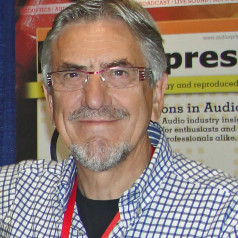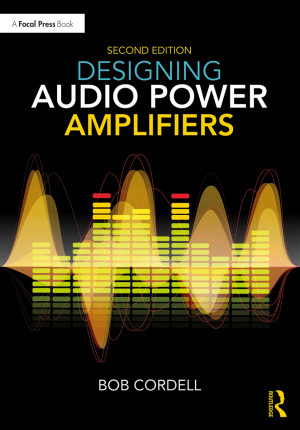 When Bob Cordell published his long-awaited first edition of Audio Power Amplifier Design, it was hailed as a significant addition to the knowledge store on the subject. Reactions of readers, both serious hobbyists as well as design professionals, made it clear that Cordell hit his mark dead center. So the second edition has been awaited with high expectations. Would Cordell be able to trump his own accomplishments? Well, let’s find out. The book is divided in six main parts. There is a clear distinction in the goal of each part.
When Bob Cordell published his long-awaited first edition of Audio Power Amplifier Design, it was hailed as a significant addition to the knowledge store on the subject. Reactions of readers, both serious hobbyists as well as design professionals, made it clear that Cordell hit his mark dead center. So the second edition has been awaited with high expectations. Would Cordell be able to trump his own accomplishments? Well, let’s find out. The book is divided in six main parts. There is a clear distinction in the goal of each part.Part 1
“Audio Power Amplifier Basics” discusses power amplifier subjects and presents all the information needed to design a basic audio power amplifier. Topics for each chapter range from transistor types and circuits, amplifier stages, current sources, voltage references, and operational amplifiers (op-amps) to design analysis, which is a sort of pulling together of all the described factors for a complete basic amplifier design.
New in Part 1 in the second edition is a full chapter to do just that: “Building an Amplifier,” which goes through all stages of a basic design, building it, testing, troubleshooting, and upgrades. This is something Cordell does in several places in the book: explaining circuits and design considerations, then pulling it all together showing how the parts fit to design a complete amplifier.
This is a very effective strategy and will help the reader quickly get to the point where he/she can apply what has been discussed. Also new in Part 1 is a chapter on noise, both from a theory as well as a practical point of view.
Part 2
“Advanced Power Amplifier Design Techniques” goes one level up, discussing advanced power amplifier design techniques. Here we find topics such as input and voltage amplifier (Vas) stages, DC servos, advanced compensation, output stages, and cross-over distortion and other sources of distortion. DC servos, you might say, what’s there to say about such a mundane well-known circuit? Well, as it turns out, a lot! For all intents and purposes, the servo is in the signal path so it merits at least the same attention as the other signal-carrying parts of the amp. Servos can also influence amplifier stability and play a role in the protection system. A whole area, often only mentioned in passing, but very important if you aim for the best.

Chapter 11, “Advanced Forms of Feedback Compensation,” is another chapter that you must absorb and understand if you want to design well thought-out high-performance audio amplifiers. Feedback compensation is the critical factor for both high performance and stability. Designing a feedback amplifier presents the eternal compromise between high loop gain, allowing vanishing low distortion, high damping factor, and the other things we like, against increased phase shift around the loop that might endanger the amplifier stability.
Learning about advanced compensation concepts in this chapter will help you find that optimum compromise in your own design. Here again, Cordell shows himself a master of explaining advanced concepts in simple, easy-to-understand terms, which only comes from a complete and full understanding of the subject yourself.
Part 2 also dedicates a full chapter (Chapter 15) to an extensive discussion of error correction concepts. The chapter concludes with a complete detailed, proven design utilizing error correction to get to extremely low distortion over the audio band. New in Part 2 is an additional chapter on output stages (Output Stages II). Here, Cordell addresses selected topics such as Complementary Feedback pairs, analyzes the interesting Bryston output stage, and discusses his own new development christened the DoubleCross output stage. This appears to be inspired by Douglas Self’s Crossover Displacement concept (which is also discussed) — where the output stage is loaded by a DC current, displacing the crossover region away from the zero output voltage point.
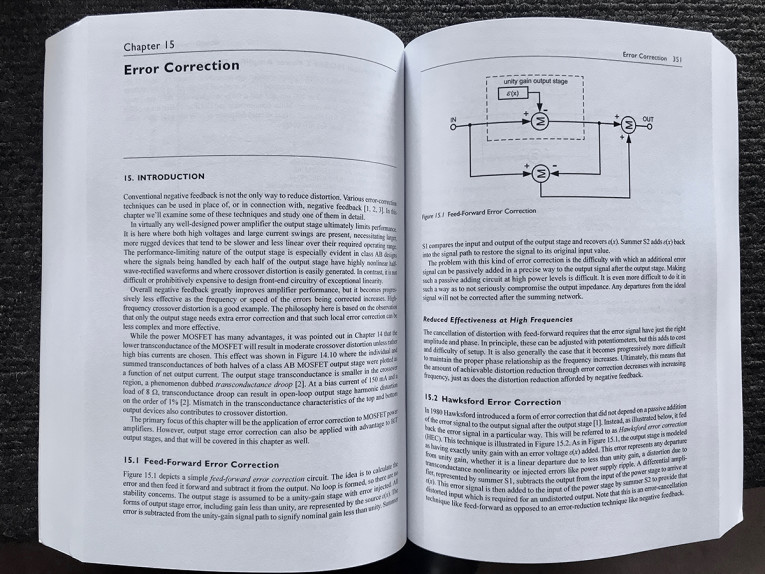
The reasoning behind it is crossover distortion is less audibly damaging when the signal level is appreciable. Cordell’s DoubleCross concept [I would not have chosen the term DoubleCross myself but am only too relieved he didn’t choose DoubleDutch] extends this to a symmetrical displacement of the crossover region—it is like having two output stages, each displaced to either the positive or the negative direction, and their outputs joined. It is a very clever development but much more involved than can be discussed here.
Part 3
In “Real World Design Considerations,” Cordell starts off with a chapter (Chapter 17) dedicated to thermal design and thermal stability of the output stage. He clearly has done much investigation into so-called ThermalTrak devices—output power devices that contain an extra diode in the case, which can be used as a temperature sensor. The incorporation of such a diode in the thermal stability loop of the output stage is a major application, but since the diode provides an accurate information about the transistor junction temperature, they could also be used in a protection scheme.
Cordell provides detailed information and design guidelines on the use of these devices and shows that they can greatly increase the accuracy and reaction speed of thermal stabilization loops. My own experiences with similar devices [I have studied thermal track darlingtons from Sanyo, while Cordell used single BJT devices from Motorola] mostly echo Cordell’s, but I found that the thermal response speed is not fast enough to track low-frequency dissipation variations over a signal cycle or burst (see Resources). At the end of the chapter, a fully developed design is presented for a power amp taking advantage of these ThermalTrak devices.
Next is a chapter on “Safe Area and Short-Circuit Protection,” going into much detail on how to design for reliability and disaster-survival, down to mitigating the possible negative effects of having a protection relay in the speaker line. (Hint: Use a very smart feedback arrangement to enclose the relay in the feedback loop yet insure that the loop is not broken when the relay opens.)
Power supplies and grounding are often neglected aspects of amplifier design. Great effort is expended to design the “World’s Best Amplifier,” only to slap on the usual transformer, rectifiers, and reservoir caps; connect all the grounds with heavy wiring, preferably in a star configuration; and assume all is well. Chapter 19 on “Power Supplies and Grounding” makes it clear that it’s more subtle than that. All aspects of transformer selection and sizing, rectifier diode selection aspects, capacitor sizing, bypassing, pre-stage voltage regulation, soft-start, grounding architectures, safety circuits, EMI aspects of power supply unit (PSU) design and safety grounds are dealt with. The chapter ends with a rather short paragraph on switched-mode power supplies, but—I should have known better.
New in Part 3 is a full chapter on “Switching Power Supplies” (Chapter 20). Almost 50 pages of everything from switched-mode power supply (SMPS) types; operational modes (e.g., continuous or discontinuous modes); regulated and open loop converters; half, full, and synchronous converters; EMI filtering and suppression; and power factor correction. After treating all these aspects with circuit examples and calculations, a separate section is dedicated to the actual use of these types of supplies in power amps and the intricacies of peak and average current demand and regulation. The only thing I missed in this chapter was a discussion of synchronous rectification, which can help to further improve the power supply efficiency, especially in Class A amplifiers.
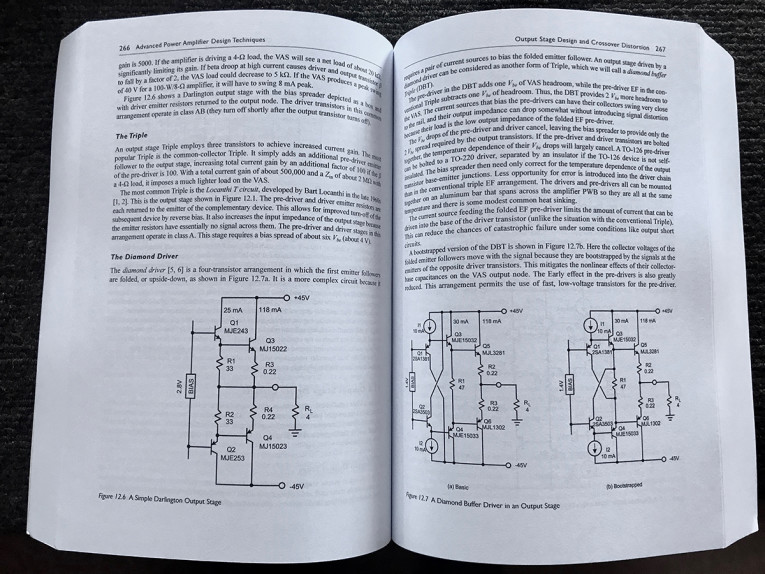
Part 4
Part 4 is about “Simulation and Measurement,” a logical combination since simulation is just measurement with other means. It starts off with two chapters on simulation, focusing on the freely available LTspice simulator originally from Linear Technology, now Analog Devices. Not just about how to make the best of the simulator itself, but also about device models, how to verify them, how to tweak them, and how to test them. This is of utmost importance because without realistic part models, a simulator is worse than useless. Cordell’s website has many device models, which he himself has developed and tested.
The sections on audio measurement are simply complete, discussing any test anyone would ever want to do on audio power amplifiers, and presents available stand-alone and PC-based test equipment. Over the years, Cordell has developed several purpose-built pieces of audio test equipment and the designs of these are available on his website www.cordellaudio.com.
Part 5
“Topics in Amplifier Design” starts off with a sensitive discussion titled “The Negative Feedback Controversy.” Here, Cordell does a very good job of dispassionately discussing the pros and cons of (global and local) negative feedback. He counters the usual arguments, that feedback “comes too late to correct what has already happened,” the “distortion goes around so grows every time” (which he calls “spectral growth”), and the other usual negative attributes with facts, figures, and reasoning. Not taking a stand, he just presents the facts and lets the reader draw the (often inescapable) conclusions.
One chapter that personally interested me is about “Amplifiers Without Negative Feedback.” Cordell is well aware of the sometimes heated controversy about this subject — some swearing by it, others eschewing it as it “kills the music.” Sensibly, he does not choose sides (although those who know him, know where his preferences sit), but clearly and succinctly explains the design trade-offs and challenges in attempting to design an amplifier with no feedback. Emitter degeneration and compensation around the Vas can also be considered (local) feedback and Cordell doesn’t use these types here either.
If you have never tried such an exercise, this is a real eye-opener! Somewhat oddly, after presenting a complete no-feedback amplifier, the chapter ends with another complete design that does use feedback, but concentrates on a design sporting very large open-loop bandwidth, 40 kHz in this case.
New in Part 5 is a chapter on “Professional Power Amplifiers” as can be found in sound reinforcement systems for performances. The requirements for such amplifiers are different enough from home sound system amplifiers to warrant a separate discussion. In professional amplifiers, it is all about reliability, high power with small size, and high efficiency. They normally have balanced inputs for low noise with long cables, and often include some form of DSP capability for advanced protection or to configure them for the task at hand.
Part 6
“Class D Amplifiers” is dedicated to the many aspects of Class D amplifiers and is a very complete overview of the technology and technical issues. Cordell starts with a discussion of basic audio Class D concepts, progressing to a chapter on design issues like filtering, sources of distortions, bus pumping and the specifics of closing a feedback loop around the output filter. Alternative Class D modulators and the requirements for measuring the performance and efficiency of Class D amplifiers round out the chapter, the part, and indeed the book.
The Upshot
So there you have it. There is so much in this book that our review can only scratch the surface, but you can think of any subject in power amp design and be sure that somewhere within its pages Cordell explains it and tells you how to get the best out of it. Almost 800 pages is A Lot!
I should also mention each chapter concludes with an extensive list of reference articles and papers. These are invaluable, allowing one to dig deeper into the relevant topics. Many of these references are freely available on the Internet and on Cordell’s own website. What remains now is to answer the question we posed at the beginning: does this second edition meet or exceed the very high standard set by the first edition back in 2011? I’d say it does.
Cordell has clearly listened to the comments and suggestions of his readers. Existing sections are expanded, concepts clarified, new material added, to the point where it has become a one-stop shop for the serious audio power amp designer.
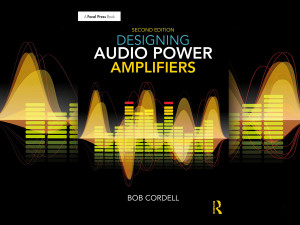 The book is not cheap, edging up to the $100 mark, but really, with a book like this, the price is only of limited relevance. You just can’t get around it if you are serious about audio power amplifier design. You need it. Period. aX
The book is not cheap, edging up to the $100 mark, but really, with a book like this, the price is only of limited relevance. You just can’t get around it if you are serious about audio power amplifier design. You need it. Period. aXResources
J. Didden, “Dynamic Measurement of Power Amp Quiescent Current—Instrumentation and Findings,” Linear Audio, Volume 8, April 1, 2015.
Designing Audio Power Amplifiers, 2nd Edition
By Bob Cordell
Focal Press, June 2019
Paperback, 772 pages
ISBN 978-1138555440
This review was originally published in audioXpress, October 2019.


